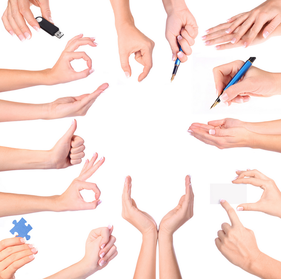Gestures are one of important aspects of nonverbal behaviors. Gestures can be broken down into five categories: emblems, illustrators, affects displays, regulators and adapters. The article "Hand Movements" by Paul Ekman and Wallance V. Friesen focuses and discusses three different gestures: emblems, illustrators, and adapters.
Emblems are a type of gesture we use to communicate instead of speech or words. The major characteristics of an emblem Ekman and Friesen suggest are (49):
Emblems obviously vary across cultures. American gestures may insult other people from different countries because different cultures have different meanings of each emblem. Here are some interesting examples of gestures:
Illustrators are a type of gesture that used to describe or accent what the speaker is said. Some characteristics of illustrators are (50):
Even though most illustrators are used widely across cultures, some of illustrators used in the United States may be translated differently in other countries. Some countries may use more illustrators than others. Here are several examples of illustrators:
Adapters are a type of gesture that includes body posture and movement to meet a personal need in communication situation. They are generally difficult to recognize. Unlike both emblems and illustrators, adapters are not intentionally used in the course of communication, in other words, they often occur at a low level of personal awareness (51). Adapters often can be clues on how a person is feeling. It is also often linked with an individual's negative feeling. "Self-adapters will increase with psychological discomfort or anxiety (52)." Here are examples of adapters:
In conclusion, gestures are often translated and interpreted differently across cultures. Different cultures have different perspectives on the usage of gestures while interacting with others. The nonverbal behaviors or movements can be misinterpreted in the course of intercultural communication if we only have a little knowledge and awareness about cultural differences. Today, as globalization progresses, it is important to be aware of the meanings of different nonverbal behaviors in order to avoid misunderstanding and sending wrong messages. Understanding body gestures can be both positive and negative powerful tool in communication.
Emblems are a type of gesture we use to communicate instead of speech or words. The major characteristics of an emblem Ekman and Friesen suggest are (49):
- They have a direct verbal translation
- They are known by most members of a social group
- They are often used with the conscious intent to send a message to the recipients
- They often occur when verbal discourse is prevented by external circumstances, by distance, by agreement, or by organic impairment.
Emblems obviously vary across cultures. American gestures may insult other people from different countries because different cultures have different meanings of each emblem. Here are some interesting examples of gestures:
- In the United States, when someone is making a thumbs-up gesture, that often means "good job," or "all right." However, it has completely different meanings. This thumbs-up gesture is an insulting gesture in some European countries.
- In the United States, when you make a circle with the thumb and forefingers, that is translated as a "okay" sign but in other places that directly translated as "zero" or "none."
- You never want to beckon to someone with one finger facing upward in Japan because it is an act of belittlement. Instead, in Japan, when you beckon to someone, "palm out ad fingers waving down."
Illustrators are a type of gesture that used to describe or accent what the speaker is said. Some characteristics of illustrators are (50):
- They are used with awareness and intentionally
- Many illustrators do not have direct verbal translations
- They are only shown by the speaker in a conversation
- They help the receiver to understand the message more easily
Even though most illustrators are used widely across cultures, some of illustrators used in the United States may be translated differently in other countries. Some countries may use more illustrators than others. Here are several examples of illustrators:
- When someone gives and tells you a direction, the person may use his fingers to point point out and to show that direction.
- When you describe your friends how big an object, you may use your hands or fingers to draw a picture in the air
Adapters are a type of gesture that includes body posture and movement to meet a personal need in communication situation. They are generally difficult to recognize. Unlike both emblems and illustrators, adapters are not intentionally used in the course of communication, in other words, they often occur at a low level of personal awareness (51). Adapters often can be clues on how a person is feeling. It is also often linked with an individual's negative feeling. "Self-adapters will increase with psychological discomfort or anxiety (52)." Here are examples of adapters:
- When I feel stressed, I tend to pull my eyebrows off. That is how I ease my stress level.
- Some people scratch their head, when they feel nervous and anxious.
- People shift position while seated to resolve an uncomfortable physical situation.
In conclusion, gestures are often translated and interpreted differently across cultures. Different cultures have different perspectives on the usage of gestures while interacting with others. The nonverbal behaviors or movements can be misinterpreted in the course of intercultural communication if we only have a little knowledge and awareness about cultural differences. Today, as globalization progresses, it is important to be aware of the meanings of different nonverbal behaviors in order to avoid misunderstanding and sending wrong messages. Understanding body gestures can be both positive and negative powerful tool in communication.

